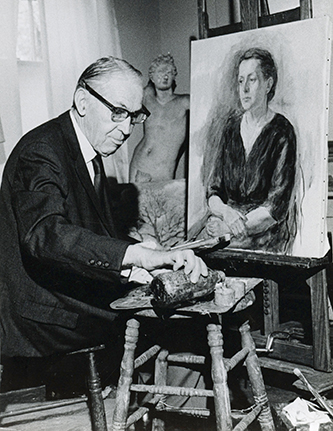11 Sept. 1896–14 Nov. 1989

Francis Wayland Speight, artist and teacher, was born at Sharrock plantation in Bertie County, the son of Thomas Trotman and Margaret Otelia Sharrock Speight. Although he had not completed requirements for high school graduation, he attended Wake Forest College from 1915 to 1917 and took art lessons on Saturdays under Ida Poteat at Meredith College. During World War I he was drafted and served for three months, and in 1919 and 1920 he studied art in Washington, D.C., part of the time at the Corcoran School of Art. In the fall of 1920 Speight entered the Pennsylvania Academy of Fine Arts, where he studied, painted, and taught part-time for more than forty years. His decision to attend the academy was influenced by an exhibition of paintings by the noted American impressionist and academy faculty member, Daniel Garber, under whom Speight studied.
In 1923 and 1925 he was awarded Cresson Traveling scholarships for summer travel and study in Europe, and in 1935 he joined the faculty at the Pennsylvania Academy. He shared a studio with Walter Gardner at 722 Sansom Street. On leaves of absence Speight taught at a number of places including The University of North Carolina, Shrivenham American University in England, Lehigh University, and DePauw University.
Although many of his earliest works reflect the landscapes of his boyhood, with Garber's encouragement in the 1920s he began painting the hilly working-class neighborhoods of Manayunk, an older industrial suburb of Philadelphia whose colorful stone and stone-stucco houses dotted the hillsides along the Schuylkill River. Although scenes of houses, factories, canals, and the river at Manayunk dominated his work from the 1920s until 1961, he occasionally painted other landscapes in eastern Pennsylvania and in Piedmont and eastern North Carolina. In the 1930s he painted a mural for the post office in Statesville depicting the Battle of Kings Mountain. In the summer of 1934 at The University of North Carolina he taught a six-weeks' art class. It was so well received that university officials soon established a permanent art curriculum.
From 1961 until his retirement in 1975, Speight held an appointment as artist-in-residence and professor of art at East Carolina University in Greenville. During this period he painted many scenes from his childhood in Bertie County as well as in Halifax, Pitt, Forsyth, and other counties. His landscapes captured with lyrical grace the cloud-dappled skies of Pennsylvania and the looming pines of eastern North Carolina. His style, which remained virtually unchanged throughout his long career, blended a concern for fleeting effects of light and atmosphere with a love for nature's contours and colors. Although abstract art flourished during his lifetime, he once implied his independence from abstractionists by saying that his work did not need an arrow on the back indicating which end was up.
Speight earned many honors for his work, including the Gold Medal of Honor from the Pennsylvania Academy of Fine Arts (1926), Hallgarten Prize from the National Academy of Design in New York (1930), Owens Award from the state of Pennsylvania (1961), North Carolina Medal for achievement in the fine arts (1964), Morrison Award from the Roanoke Island Historical Association (1973), and O. Max Gardner Award from The University of North Carolina (1976). He received honorary doctorates from Wake Forest University (1962) and Holy Cross College (1964) and was elected a member of the National Academy of Design in 1940 and to life membership in the National Institute of Arts and Letters in 1960. In 1961 he was the first North Carolina artist to be honored with an exhibition of his works in the newly opened North Carolina Museum of Art in Raleigh.
His paintings are owned by museums in North Carolina and by the Metropolitan Museum of Art in New York, the Boston Museum of Fine Arts, the Philadelphia Museum of Art, and museums in other cities in the United States and in Canada.
In 1936 Speight married Sarah Jane Blakeslee, a student at the Pennsylvania Academy of Fine Arts who worked as a portrait and landscape painter. They were the parents of a son and a daughter, Thomas B. and Elisabeth S. He was buried in Greenwood Cemetery, Greenville.